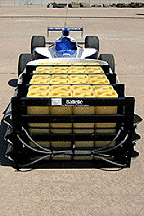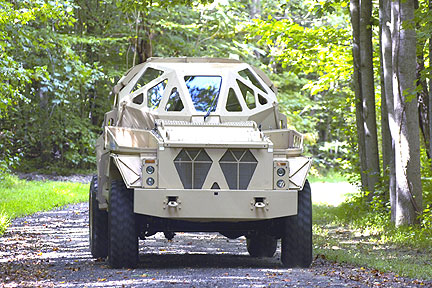Accident damaged guardrails and sand barrels for crash protection along our highways could be a thing of the past. They could be replaced by new self-healing automotive crash-barriers. These barriers are made of a material that recaptures its original shape minutes after a crash.

|
| The honeycomb-like polyurethane cells in self-healing impact barrier for NASCAR pit-stop walls reduce G forces by as much as 60 percent, but they return to their original shape in a matter of minutes. (Battelle) |
The material is a type of polyurethane originally developed for NASCAR by Battelle Science and Technology in Columbus, OH. Here it is used on the leading edge of the concrete wall that separates pit row from the race lanes. Testing has demonstrated the ability to take head-on and 20-degree impacts at speeds up to 100 miles per hour and still regain its shape. It has been tested a dozen times with vehicle impacts including NASCAR race cars and three-quarter-ton pickups.
After a dozen impacts, there isn't any change. It takes a few minutes to get back to its original configuration. After ten minutes, you see 98 percent recovery and after 30 minutes, it's back to the original shape.
The energy-absorbing hyperelastic form of polyurethane is made using a proprietary process that removes brittleness no matter how hard or fast it is deformed. "Most materials, as you impact it at faster and faster rates, they will have more brittleness," says Jay Sayre, a materials scientist at Battelle. "But this material doesn't go through a brittle failure. It is important that it doesn't rebound too quickly." This could cause a crashed vehicle to bounce back into lanes of traffic.
Current sand- or water-filled barrels and steel cages with plastic boxes that crush are essentially one-time-use systems. Once they are damaged, they need to be replaced. It can often take days or weeks before crews can make repairs. Meanwhile, the chances are good that another crash can happen before guardrails and barriers can be repaired. Also repairs expose crews to danger. "If we put these in high-accident locations, it's immediately ready after an accident to absorb a second crash," says Dean Focke, roadway standards engineer for the Ohio Department of Transportation.
The Federal Highway Safety Administration and the Ohio DOT, are currently evaluating the technology. Two companies that manufacture highway safety barriers have already licensed it. Battelle hopes to have a product on the market by summer 2007.

|
| The ULTRA AP (Armored Patrol) includes technology increased survivability based on NASCAR expertise. |
This is just one technology spunoff from NASCAR. The U.S. Army is currently looking for a replacement for the Humvee that has be in use for some twenty years. One candidate design is the ULTRA AP developed by a Georgia Tech Research-led team of experts including those with NASCAR racing expertise. The design includes a survivable crew capsule for the four occupants based on NASCAR experience. This egg-shaped "blast bucket" provides ballistic, blast and enhanced roll-over protection.
The Army is also looking at using liquid cooled garments that were developed by NASA using a cooling package like used by NASCAR racers. The ability to reduce body temperature should provide more comfort to soldiers both inside and outside vehicles. The electrically-driven integrated refrigeration package is just the ticket for soldiers operate in a harsh, hot environments.
NASCAR technology is not only used by the military. For instance, TriMet buses in Portland, OR are using systems developed by Michigan-based EMP Inc. that replaces original hydraulic and belt-driven cooling systems and with electrical components. Besides boosting fuel economy by up to ten percent. According to TriMet, the new systems should also boost a bus' horsepower. The system is like that often found in NASCAR racers.




